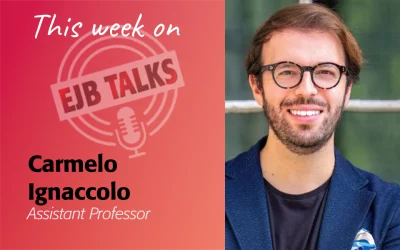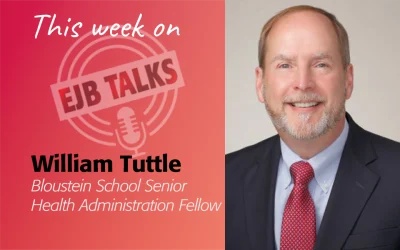COVID-19 has monumentally changed how we have lived for the last five months, with most of the population quarantining at home. In previous episodes, we examined the effect the quarantine has had on some of our most vulnerable populations. This week on EJB Talks, we explore a population that can be particularly affected by stay-at-home orders–those facing intimate partner violence. Stuart Shapiro talks with Professor Andrea Hetling, director of the Bloustein School’s Public Policy program, who discusses how non-governmental organizations and governmental agencies are beginning to work together to find creative solutions to relax some of the most difficult hurdles, and provide assistance and help to those who need it most.
Stuart Shapiro
Welcome to another episode of EJB Talks. I’m Stuart Shapiro, the Associate Dean of Faculty at the Bloustein School. And the purpose of this podcast is to talk with my colleagues and our alumni about issues affecting people in New Jersey, the United States and the world.
The effects of the quarantine due to COVID-19 over the past few months will be felt for a long time. Nowhere will they be as felt as deeply as among the most vulnerable members of society. Professor Andrea Hetling directs the Public Policy Program at the Bloustein School and researches the effect of public policy on the most vulnerable. Professor Hetling, thanks for joining us.
Andrea Hetling
I’m very excited to be here. Thank you, Stuart.
Stuart Shapiro
Great. Can you start by just telling our audience about your research, particularly as it pertains to intimate partner violence?
Andrea Hetling
Sure. So I feel like I need to start from the beginning. If I go all the way back to the beginning before entering into academia, I worked for a while after college at a nonprofit organization in New York City that worked with survivors of intimate partner violence. So in my work with the nonprofit agency in New York City, I was doing mostly advocacy and development work. But where my office was situated, I often interacted with some of our families. And in my work, and going to the state capitol in Albany, and interacting with legislators and funders and our board of directors, I saw really firsthand how issues of intimate partner violence and poverty would interrelate. Many of the families that we served, struggled with finding the resources they needed to leave an abusive relationship, and really remain free and able to continue on with their lives. So much of my research has really focused on this interaction or this sort of intersection between experiences of violence and experiences of poverty.
Stuart Shapiro
And so yes, that obviously points towards some of the problems that our current crisis leaves potential victims of intimate partner violence in right now. Can you talk a little bit about the current situation, given that we have COVID-19, and most people are supposed to stay home? Given that we have an economic downturn and how that’s affecting intimate partner violence?
Andrea Hetling
Sure. So one of the key characteristics of the situation of experiencing violence or sort of the dynamics of an abusive relationship is such that the perpetrator… we often talk about sort of the perpetrator needing to maintain power and control over his partner. So what that sort of means, even though most of the time when someone thinks about intimate partner violence, our minds oftentimes go directly to sort of physical abuse. But other types of abuse are as, or perhaps more common, and really sort of a foundational aspect or characteristic of many relationships. So, I can give you an example.
Power and control. One of the most effective ways, if you will, of maintaining that type of power in a relationship would be to isolate the other person. Isolate them from resources, from family, from friends, from social networks. The more sort of isolated an individual is, the harder it is for that person to reach out for help, to access services, to engage, and find avenues or pathways out of that abusive relationship. So, oftentimes in an abusive relationship, we’ll see what we have characterized as financial abuse. The perpetrator, in addition to isolation tactics from family or friends, could also cut off an individual’s access to resources. So, demand things like seeing a receipt after going grocery shopping, be the one that manages the checkbook, prevent someone from going from work or to work, or from accessing higher education. This sort of isolation or this cut off from finances is also a common strategy that’s used by perpetrators of intimate partner violence.
So when we think about the situation that we’re living in now with the COVID-19 pandemic and many states experiencing or having these various versions of stay-at-home orders or quarantine, this further isolates all of us from what we typically see in our everyday lives. And for survivors or someone that’s residing with an abusive partner, this type of isolation just exacerbates the challenges that they’ve already been experiencing within that relationship.
Stuart Shapiro
Right. So essentially, it’s given the perpetrator far more tools to use for abuse. You can’t go out because you might get exposed or you can’t go out because you’re not allowed to go out, something like that.
Andrea Hetling
That’s exactly right. So it could be used as an excuse for controlling behaviors, and even framed as “I care about you so much. I can’t let you go out right now.” It also, sort of, takes that controlling behavior out of the picture. It also just makes it harder for all of us, survivors included, to be able to reach out to friends. It’s harder to kind of, go over and say hi to your neighbor or when you’re not going to your house of worship, or to your kid’s school. Those everyday interactions, which under normal circumstances might provide opportunities for reaching out for help, they just don’t exist anymore.
Stuart Shapiro
Right. And this is made worse by the economic downturn, I would imagine.
Andrea Hetling
Yeah, so that makes it definitely harder for many families. Those experiencing violence included. And I would actually also when I think about the economic downturn, even think more about the challenges faced right now by service providers. So, agencies that help domestic violence survivors, one of their key services is providing emergency housing. Well, we have a situation right now where finding housing is really difficult. So those that are currently in emergency housing may not be exiting as quickly. And when there’s an increased demand for your services, how do you serve all of the individuals that need help in this current environment?
Stuart Shapiro
Right. And if you think of an idea, like a shelter, grouping people together indoors is the exact opposite of what we’re supposed to be doing, right now.
Andrea Hetling
That’s exactly right. And you know, if we think back to March and April on the difficulties that many of us had grocery shopping and thinking about hygiene and sanitation needs and finding those coveted Clorox wipes, all of those types of challenges for shelter providers were really… were REAL and really necessary at that time.
Stuart Shapiro
Those Clorox wipes are still impossible to get as far as I can tell!
Andrea Hetling
Oh, I got some recently… I’ll talk to you afterward. (laughing)
Stuart Shapiro
You have a source! Very interesting…
Andrea Hetling
Yes, I do. (laughing)
Stuart Shapiro
Now one solution, of course, is for the government to provide a robust social safety net. And to some degree, the government has stepped in with this, but I’m guessing there have been weaknesses here too, particularly over the last several months.
Andrea Hetling
That is true. Although I am heartened to see the amount of flexibility and grassroots responses. That creativity, of course, is partially dependent on the amount of resources necessary. And we definitely are seeing an increased need among the domestic violence agency community and service providers for those additional resources to help serve those in need.
Stuart Shapiro
Right.
Andrea Hetling
At the same time, in terms of the public social safety net or cash assistance, SNAP, or some of you may know it as food stamps, these types of public assistance continue to be available, and in certain circumstances, perhaps slightly more available.
For example, pre-pandemic, in order to apply for cash assistance or TANF or sometimes known as welfare, families would often need to go to a county office to apply in person. Or at the very least, even if they started an application online, to go to turn in documentation, or proof of an electric bill or income or rent or other types of documentation. Now with the stay-at-home order, individuals working from home, agencies practicing social distancing and others, there have been a number of waivers that have come out of the federal government that has allowed states and counties to basically explore other ways of engaging individuals. So we’re seeing offices that are engaging with clients more on the telephone, that is allowing individuals to fax in documentation, or waiving the need for documentation altogether in certain circumstances.
Stuart Shapiro
Yeah, that’s great. Administrative burden is one of the secret ways we restrict access to benefits and so it’s good to see that that’s being waived. You know, we talk about public policy often being about trade-offs. You know, you fix one problem, you exacerbate another. And to some degree, the solutions we’re using to fix COVID-19 are exacerbating problems for the most vulnerable. What else should policymakers be doing or thinking about as we wade through this crisis?
Andrea Hetling
So I think this piece of access and engagement are really the keys here. Opening up pathways, ways for individuals to reach out, ways for people to communicate, and access the very benefits that are out there and should be available to individuals. As you said, decreasing administrative burden and thinking creatively of ways to engage families. Having a telephone conversation is not always the most personal interaction. So making sure that caseworkers, that human service workers, have the skills to engage with individuals in that way. Having trauma-informed training available for staff. Training regarding cultural competency, inclusion. When we think about the additional challenges faced by particular groups such as immigrants, we want to make sure that those services, this safety net, is really accessible to all individuals who need it.
Stuart Shapiro
I see. So we try to end sort of on a hopeful note, it’s sometimes difficult and sometimes my guests don’t always comply, for good reasons. Not to blame them, of course. But one of the ways to think about, that is to say, you know, are we learning anything? Is there anything that we are picking up in this experience of the pandemic and the recession that will allow us to make better policy, even after we are done, after we’re through this?
Andrea Hetling
I’m quite hopeful for that, “after we’re done,” as you put it. I’m not sure when that will come.
Stuart Shapiro
I know!
Andrea Hetling
And I’m, you know, more concerned about the immediate future. But when I look long-term, a lot of these creative, innovative strategies that are really emerging from community organizations from the frontlines of domestic violence organizations, from the frontlines of TANF county agencies, we’re seeing these various sort of solutions. I was on a call recently where someone kept talking about telephonic communications, and it made me giggle a little bit because I sort of felt like we were back in, you know, Alexander Graham Bell was telling us about the telephone. But it’s true. I mean, we haven’t made use of a lot of technologies in this way. So I am hopeful in that way.
There are a number of organizations of umbrella networks, the National Network to End Domestic Violence, the National Association of Welfare Research and Statistics, that are really coming together. That having these webinars and discussions to facilitate sharing information so that we can all understand potential best practices and hopefully push for legislation that allows them. And I think that that’s where I’m a little… it’s more I might call for action. I don’t think that the change is going to necessarily happen very easily. Some of the regulations and policies that are in place that, as you put it, put up these hoops or this red tape for access. They are there on paper, so changes aren’t going to need a push in changes in state legislation and national legislation. And I think it’s important for the advocacy community to come together and push for that.
Stuart Shapiro
I will say that the issue of administrative burden across government, I think, is getting more attention. And so I’m hopeful that, you know, whether it’s at the local, the state or the federal level, that we can bring attention to that. And that as the politics change, that some of the policies will change in that area. And the other issue, of course, is to disseminate. I mean, if these practices are bubbling up, they have to be disseminated in order to work as well, so that they have a broader effect.
Andrea Hetling
That’s exactly right. And I think that’s why these webinars have been really important and it’s been super interesting for me as a researcher to be able to get onto these calls and hear the state of Vermont talking about their practices. Hear individuals in Tennessee talking about their practices. And I think that there’s a pretty strong network of individuals of agencies and a real ability to share those right now. So I’m very hopeful on that front.
Stuart Shapiro
Well, we’ll take that as the hopeful note on which we’ll end the podcast. Professor Hetling, thank you very much for coming on.
Andrea Hetling
Thank you so much for having me. It was a really great conversation, and I look forward to listening to the other podcasts as well.
Stuart Shapiro
Wonderful. A big thank you to our production team, Tamara Swedberg, Amy Cobb, and Karyn Olsen. We’ll be back next week with another talk from another expert at the Bloustein School. Until then, stay safe. Thank you.




